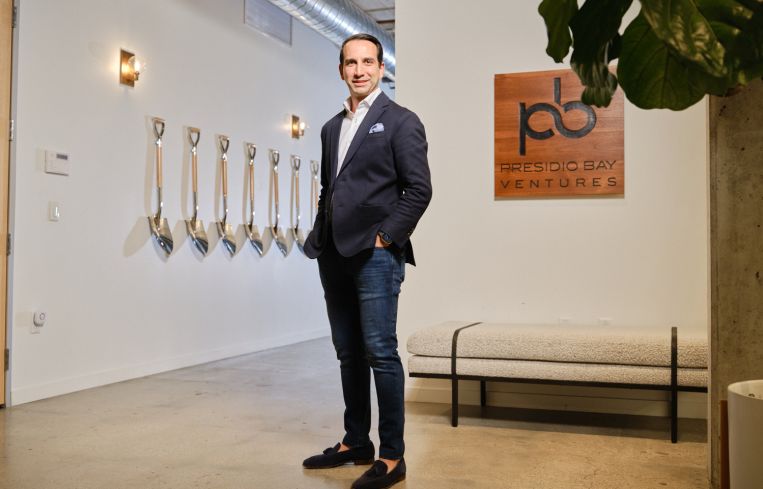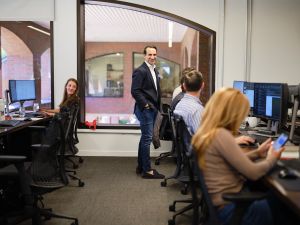Presidio Bay’s Cyrus Sanandaji On San Francisco’s Comeback and More
The company, and its branding and buildout wing the Main Post, are behind the concept of the ‘office resort’ — let him explain
By Mark Hallum September 10, 2025 12:41 pm
reprints
Having traversed many winding roads in his professional and personal life before eventually landing in the San Francisco Bay Area — where he’s taken a prominent role in reshaping the commercial real estate landscape — Cyrus Sanandaji has ended up staking a major claim in the industry through his reliability.
Sanandaji was born in Los Angeles to an Iranian Kurd father who worked in shipping, but grew up in Dubai before its big development boom. He moved to England with his family and returned to the States in the early 2000s, where he bounced around for school, then followed a series of job leads.
He worked his way through college at the University of California at San Diego in a family real estate office, and then moved to Oxford, for grad school. It was back to the United Kingdom after that for Sanandaji. That chapter was short-lived, however, when he was recruited to work in real estate for the U.S. General Services Administration, the federal government’s civilian landlord, based in San Francisco.
Little did he know at the time, the company Sanandaji would help establish in 2012 would be making deals with the federal agency to transform a major site outside of San Francisco in a “full-circle moment.”
Most recently, Presidio Bay has been making moves to capitalize on the reinvigorating Bay Area office market with the launch of its hospitality-driven real estate services arm the Main Post, and is repositioning a 183,585-square-foot office building in the heart of San Francisco’s central business district at 88 Spear Street. The tower will take office amenities to a new level with a resort twist, offering sauna rooms and a rooftop restaurant.
In nearby Menlo Park, Presidio Bay sealed the deal on an 18-acre campus known as Rockaway Grove which could yield from 600 to 1,000 units of housing and 600,000 to 800,000 square feet of commercial space once redevelopment efforts are ironed out.
Sanandaji talked with Commercial Observer on Aug. 7 about his fortuitous big break in real estate, his early days, and his current plans.
This interview has been edited for length and clarity.
Commercial Observer: How did you get your foot in the door with the GSA?
Cyrus Sanandaji: I was on a flight from San Francisco back to Europe and met this guy who I thought was a literature professor at Cal. Our flight was delayed, we started having a long conversation, there’s an empty seat between us, and he’s like, “Do you want a drink? Because I’ve got like 1,000 of these free drink coupons…” A 12-hour conversation later, I tied this whole thing together about how I would love to serve, I love the idea of being in government.
At the end of the flight, he handed me his business card — national program director for the FBI, ran all of their facilities in development, based out of the GSA, charged with building all of the new field offices post-9/11. He said, “I’ve interviewed you now. If you can pass the security clearance, you said you wanted the intersection of real estate [and government] which you have experience in, and I have the job for you.”
It was just one of these random, happenstance moments. … If I don’t take this chance, I’m gonna kick myself down the road.
He gave me this incredible opportunity, leaned into all these things that there’s not a single firm on the private equity, finance or development side that would have given me that responsibility at that age with the experience I had. He was like, “Do you want to study facilities management? There’s a grant or there’s funding for that.” So you’re not getting paid much, but you’re learning priceless things.
The crazy thing is that I don’t think I could have ever charted that out. And, in hindsight, I would do that 10 out of 10 times the exact same way.
Tell us about starting Presidio Bay.

I had done a bunch of deals with private contractors on the government side of the table as a contracting officer, and I kept looking at the other side of the table and thinking that I would enjoy doing that. I felt like I had done enough within the context of what I can do in the government and hitting the limits on what change can be implemented within a large bureaucracy.
So Presidio was really my first attempt at testing how I can go and leverage the relationships and skills that I had built. I had never raised a single dollar in my life up until that point because family offices and the federal government had money. That was a skill I had zero expertise in.
Capital providers would ask, “What’s different about you, or what’s where’s your edge? Why should we take a risk with you?” I would say, “I’m not asking you to take much of a risk. The only thing you need to bet on is our ability to actually build the project, because we’ve secured these government leases, the sites are tied up. So you have no market risk. There’s no income risk. Your only risk is us being able to actually have the architecture and the general contractor and all of that stuff coordinated in the way that we can build the thing and deliver it so the tenant starts paying rent.”
And, mind you, I had done X million square feet of the same exact stuff for the last three and a half years.
We ended up doing about 15 of these build-to-suits all around the country, and I was young. I didn’t have a family, and I lived on an airplane, and I was a one-man shop for two years, doing everything from sourcing the deals, negotiating the leases, financing it, project managing it, doing all of that. And then that’s when Kabir Seth, my business partner, joined two years in, and it was the two of us for the next two, three years.
How did you manage these projects by yourself?
There were a number of really great people who were really good to us, who, in turn, helped us make a lot of money, sort of symbiotically. I didn’t have anything, I didn’t have a balance sheet, I didn’t have capital. There was a family office who knew that and said, “It’s OK, you don’t need to co-invest, but you’re not getting fees, you’re making the entirety of your money on the back end to make sure you work your ass off.” I’ll take that. I’ll bet on myself.
We got a bunch of nice promotes early, and then that became the seed money that we kept reinvesting into the business. Fourteen years later, we still haven’t taken on outside capital, no one else owns the company. It’s all third-party, limited partner money in all our deals, but a lot of people will do co-general partner things, or raise GP funds, or somehow, one way or another, show up with family money, or one of the partners has family money or a balance sheet, or they borrow balance sheets.
We just followed our own journey, and the growth was much more organic. It was a lot slower than a lot of other new firms, but, sitting where we are today, I’m grateful that we did that and we built the systems, the people and everyone that we have at the firm.
How big is Presidio Bay now?
We’ve got 20 people on the investment and development side, and then we have a separate [operating] company [of roughly 30 associates covering various verticals]. So the management and construction, property management, the brand agency, the construction management side, all of that, we spun out as a third-party business a couple years ago called the Main Post. So they’re a sister company.
But the real reason for that was that we wanted to start offering third-party services to a lot of our capital partners on broken transactions, foreclosures, things like that, or to tenants that were otherwise not going to our buildings but who are friends of ours.
We have a bunch of startup and tech companies that are here in New York, all headquartered there. They all grew all over the country. We weren’t going to be able to keep them in our portfolio because Presidio wasn’t big enough to be in all those places. But how do you continue to service your clients, your customers, with that mindset and go with them where you’re not capital constrained anymore? There’s a big opportunity to build an enterprise, a company that actually has real recurring revenue and can operate at a national and, hopefully, international level.
We’ve gone full cycle: Louisiana, Texas, Wisconsin, Arizona, Nevada, California, Washington, Guam. We built some law enforcement facilities out there that we still own and operate with a local partner, and it was one of our first deals. That set the baseline that established that we can actually really operate in a nimble way, even though it’s not this massive company.
How did you come to focus on the greater San Francisco markets?
As the Bay Area started heating up, we started investing a lot more in the Bay Area, naturally, because it was our backyard. I also got to a point in my life where I didn’t want to be on an airplane every week.
So we have three business lines: the mission-critical platform that sort of does build-to-suits and we’re buying existing properties from other merchant builders, and that’s more of a core, core-plus tech strategy. On the development side, we’ve got commercial development: traditional office, creative office, R&D life science labs — that sort of food group. And then we’ve got high-density infill housing, both for sale and for rent.
But what we’ve done is we’ve started to put a lot of that together into these mixed-use settings. And that’s really what, if you think of Presidio Bay today, I think people view us as a truly vertically integrated, mixed-use developer and owner-operator.
How have you stabilized the company against downturns?
By chance. By the time the pandemic hit, we had exited a bunch of deals at the end of 2019 and early 2020, and the deals that we kept were longer-term lease deals. Then the development deals that we had were unlevered, because the stuff that we had bought in 2018, 2019 and 2020, there’re all the LPs — not the Fortresses, but the pension funds which had so much capital that they’re like, “Why would we pay someone else when our cost of equity is the same? Let’s just do it on lever.”
Again, better to be lucky than good. That saved us, because otherwise all of these large land positions would have been gone. So now we’ve got this great pipeline of shovel-ready projects that won’t go vertical for probably four or five more years, realistically. So, in five years, we’ll have this phenomenal portfolio. Now, in the interim, we’re buying everything that we can that makes sense in the right markets at substantially below replacement cost.
We’re buying existing with some component of value-add or just core-plus money.
Why are you looking at the four- to five-year mark?
Life science is nearly 40 percent of the Bay Area vacancy, office in San Francisco is 35 percent and dropping. We were trending in the wrong direction for four years. So until all of that vacancy really gets to a healthy place like 5 percent or below, I don’t see a lot of capital wanting to take vertical risk when you can buy stuff for substantially below replacement cost today.
So if we’re buying a Class A office tower for 400 bucks a foot, and it costs us $1,000 to build, until that $400 is worth $1,000, it just doesn’t make sense to build. Our view, conservatively, is that on the commercial side, it’s going to take the better part of four to five years to get to that place where then we can go vertical on our shovel-ready stuff.
In multifamily, I think it’s going to happen a lot faster than we think. We’re seeing this compression right now on return to office — and it’s not just San Francisco, it’s across the Bay Area. Like Menlo Park, Facebook, Meta had a return-to-office mandate at the beginning of the year. Since then, we’ve seen 25 percent rent increases on the median one-bedroom monthly rent in Menlo Park.
That’s where the dislocation happens. Like, when they all said, “Go live wherever you want to go live and don’t come to work,” the multifamily and the office markets collapsed as a result. We’re just seeing the inverse of that happen. So this is like the whiplash of the Bay Area — boom and bust. It’s in full force. And multifamily has been structurally undersupplied for so long that you’re going to see the limits hit. In terms of vacancy rates, they’re going to drop substantially back to pre-2020 levels in a very short period of time.
Tell us about what you’re working on at 88 Spear Street.
We bought that about two years ago, and we think we timed the bottom, and the whole thesis was that the building is going to become vacant, which is great. We have an opportunity to completely rethink how an office building should be in 2025 and beyond, and we coined the term the “office resort.”
People are perfectly happy being in a B-plus building if they get an outstanding experience. I think buildings like 22 Vanderbilt in Manhattan and a number of others have proven that they’re outperforming some of the trophy assets because of how cool of a draw that experience is, right? That’s our entire thesis. There’s nothing else like that in the market in San Francisco, and we’re under construction. We have a lease out for two floors, bottom two floors, $105 starting rent.
Tell us about the 18-acre campus in Menlo Park you purchased from the GSA. Did your roots in the government help bring that together?
Exactly. We knew that they wanted to sell it. We’ve been pursuing it for five years, six years, and ever since we did the Springline project [a 6.4-acre mixed-use development] we had more and more conviction on some of that market and really establishing roots there with the community, with the electeds, all the different companies that were there, and realized that we wanted to be there for the long run.
First go-around when the GSA tried to sell it, the structure was really, candidly, inefficient and onerous on the buyers. We had a capital partner lined up and were really excited, but we just couldn’t come about being the first bidder. For whatever reason, no one else bid. The auction closed, and the government was like, “Well, guess our structure didn’t work for anybody,” even though we were there. So we tried to approach them after the fact to buy it. They said you’ve got to wait while we do all this environmental remediation. They finally moved off campus earlier this year.
Mark Hallum can be reached at mhallum@commercialobserver.com.
Editor’s note: This article originally misstated where Sanandaji went to graduate school, and the square footage of 88 Spear.


